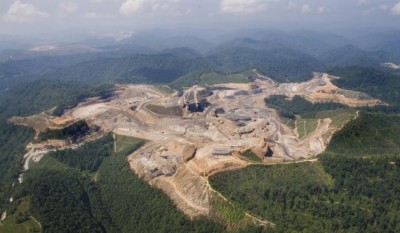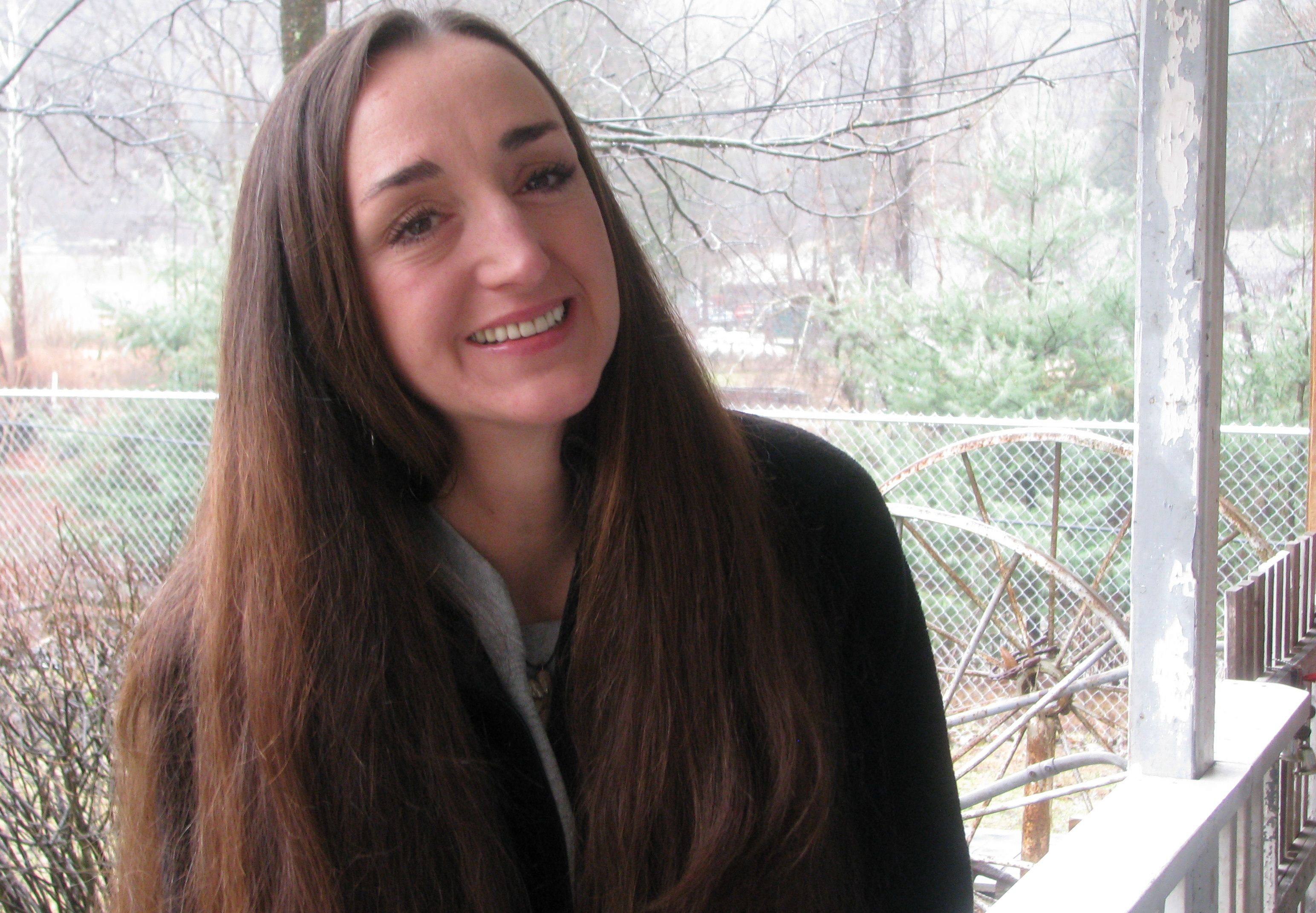 Mountaintop, removed. Near Rawl, West Virginia.Courtesy of ILoveMountains.org
Mountaintop, removed. Near Rawl, West Virginia.Courtesy of ILoveMountains.org Maria Gunnoe.Tom DusenberyWest Virginian Maria Gunnoe won a prestigious Goldman Environmental Prize this week for her work fighting the devastating practice of mountaintop removal mining. It’s hard to think of someone more deserving of the prize, which includes a $150,000 award. Gunnoe, 40, has seen her family’s ancestral home flooded seven times since coal-mining companies built two toxic-waste ponds above the Boone County property. Mine waste poisoned her well and drinking water. After she began working against coal companies in 2004, “wanted” posters of Gunnoe appeared in local convenience stores, and her daughter’s dog was shot.
Maria Gunnoe.Tom DusenberyWest Virginian Maria Gunnoe won a prestigious Goldman Environmental Prize this week for her work fighting the devastating practice of mountaintop removal mining. It’s hard to think of someone more deserving of the prize, which includes a $150,000 award. Gunnoe, 40, has seen her family’s ancestral home flooded seven times since coal-mining companies built two toxic-waste ponds above the Boone County property. Mine waste poisoned her well and drinking water. After she began working against coal companies in 2004, “wanted” posters of Gunnoe appeared in local convenience stores, and her daughter’s dog was shot.
Despite these obstacles, Gunnoe, a member of the Ohio Valley Environmental Coalition, has kept up the fight, organizing community members and working successfully for the closure of several mines and for tighter regulations on those that remain open. (Read Jeff Biggers’ profile and check out a Grist photo series for more.)
Reached by phone yesterday, Gunnoe sounded alternately energized, calmly optimistic, and as ticked off as ever about what’s happening to her homeland. Here are the highlights of our conversation.
Q. First off, congratulations. How do you expect the prize to change your work and how you’re able to get your message out?
A. When people find out that mountains are blown up because of their electricity consumption, they tend not to like that. So the awareness is as important, if not more important, than the money.
Q. And what about the $150,000?
A. By the time I pay taxes and pay to have water run into my house, I might have enough left to go grocery shopping. My water is polluted with selenium and other things so I can’t use the water that comes into my house right now. We have to buy water in gallon jugs. In order to get city water access I have to get it run in about a half mile from any direction. They want $31,000 to make that happen.
We’ll put it this way: the coal industry destroyed our property. They destroyed our water and our access bridges, so just getting access and healthier water into our property could take much of that money. And $150,000 really isn’t that much when you’re talking about fixing the destruction of the coal industry.
Q. Was there a defining point for you in turning from a citizen into a mountaintop removal activist and leader? How did that happen?
A. It had more to do with the fact that I’m a mother than anything else. I started looking into what my children’s future was going to look like, and it didn’t look good. The best thing I can do for my children is to educate them and to see to it that they have a healthy world to bring their grandchildren into. And it’s not that way right now.
 Gunnoe’s West Virginia home.Tom DusenberyQ. You’re the third woman from West Virginia to win the Goldman Prize. What is it about this part of the country that produces so many tough-as-nails women who fight against mountaintop removal from their own doorsteps?
Gunnoe’s West Virginia home.Tom DusenberyQ. You’re the third woman from West Virginia to win the Goldman Prize. What is it about this part of the country that produces so many tough-as-nails women who fight against mountaintop removal from their own doorsteps?
A. Well, we’re fierce mothers. That’s the only way I know to explain it. Appalachian women are very concerned about the wellbeing of their children, their grandchildren, and their great grandchildren, because the things that sustain life and culture in Appalachia are being destroyed. The water, air, land, the plant life—everything.
Q. So many people who use that electricity don’t live in Appalachia, and get their water from somewhere else. How do you show them the full consequences of the way coal is mined?
A. One of the best ways is to ask them to come to Appalachia and see for themselves. Because you can’t fully explain mountaintop removal to people. They need to experience mountaintop removal. It is so big that it’s almost like the human mind doesn’t have the capacity to absorb the enormity of it.
Another way is to go to iLoveMountains.org. Put in your zip code and it will tell you exactly what mountain was leveled to power your home. It will tell you where the coal comes from that powers your home.
Q. What’s the feeling among people on the ground about how the Obama administration will handle mountaintop removal and coal mining?
A. On the ground, there’s not much happening. Everything that’s happening is on paper. On the ground, mountains are being blown up. If anything, it’s exacerbating things by making mining companies move faster. They’re afraid they’re going be stopped, so they’re getting what they can while they can.
Q. Has Obama’s Office of Surface Mining signaled that it’s going to start doing things differently on these issues?
A. They’ve not sent clear signals. They’re reviewing permits, but there’s nothing coming from that. It’s better than the Bush admin where they just rubber-stamped permits. The Obama administration has made steps toward reviewing these permits for environmental impact, but there’s nothing really happening. The people who live in these communities expect an all-out ban on mountaintop removal coal mining, and we won’t give one inch until we get it.
Q. I heard you were meeting with senators this week. Were you able to say that to them or to anyone from the administration?
A. I was able to say that to my senators, and they very much disagree. They think we can have some sort of compromise on this and everybody can come to an agreement of how to do mountaintop removal more “environmentally consciously.” But you cannot blow up a mountain and be environmentally conscious. There is no building that mountain back.
Q. What do you make of reports that Obama wants to appoint Glenda Owens, a Bush mountaintop removal architect, to lead the Office of Surface Mining?
A. I have an idea: let’s put somebody in charge of the Office of Surface Mining who lives where I live, and let them help set these laws. The people who are running the federal and state regulatory agencies are never the people who are living with the impacts of mountaintop removal. It’s almost like they turn a blind eye to it. They don’t want to know.
Q. Are enough people in West Virginia and Appalachia waking up to the full cost of mountaintop removal to create real change?
A. Absolutely, especially with the exacerbated mining they’re doing now — they’re moving at a pace beyond anything I’ve ever seen. People are definitely waking up to it, because they’re waking up every single morning and every evening with blasting near their homes. Their homes are being shaken off their foundations. Their air is laden with silica dust from the blasting.
And people across the world are waking up to it, too. People are beginning to connect their consumption with the demise of the Appalachian people. And they don’t like it.
Q. Anything else?
A. The Appalachian people have been promised prosperity through coal for the last 125 years. And we’re poorer now, because we used to be rich in the abundance of the land, and now that’s been taken away. And there are fewer jobs than there have ever been here. I think it’s time to keep that promise of prosperity in the form of green jobs, which have a real promise for the future. That’s the only way we’re going to pull ourselves out of this slop.



